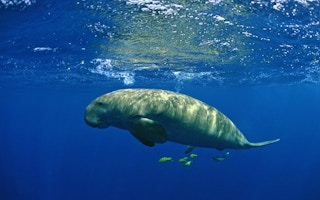Time, tales and travels have created myths of half-human, half-fish creatures across the world. While such mermaid legends live on, their likely inspiration, the dugong, is slowly dying off.
To continue reading, subscribe to Eco‑Business.
There's something for everyone. We offer a range of subscription plans.
- Access our stories and receive our Insights Weekly newsletter with the free EB Member plan.
- Unlock unlimited access to our content and archive with EB Circle.
- Publish your content with EB Premium.
Now, these marine mammals may be gone for good in China, where there have been no recorded sightings since 2008, say researchers from the Zoological Society of London and the Chinese Academy of Sciences.
This may be the first “functional extinction” of a large mammal in China’s coastal waters, the scientists added, even as they continue to “welcome any possible future evidence that dugongs might survive in China”.
A species is considered functionally extinct when their numbers are so low that they no longer play a significant role in their ecosystem, or experts believe there are so few of them left in the wild that they will all but die out.
The researchers had surveyed fishing communities in China’s southern coastal villages in 2019. Only 37 of nearly 800 respondents said they had spotted dugongs; many of these sightings happened a considerably long time ago – the average date reported was 23 years prior. Only three people reported having spotted dugongs after 2014.
“Our study provides evidence of a new regional loss of a charismatic marine megafaunal species,” the paper stated.
“This rapid documented population collapse also serves as a sobering reminder that extinctions can occur before effective conservation actions are developed,” it added. The dugong had been on China’s list of most protected wildlife species since 1988.
Dugong in distress
Dugongs, which grow up to four metres long, weigh hundreds of kilograms and live for over 70 years, occupy an ecological niche as the only strictly vegetarian sea-dwelling mammal. It lives on a dwindling supply of seagrasses along coasts stretching from East Africa to the Pacific islands.
Once hunted for its flesh, oil and bones, these animals, also known as sea cows, gradually entered national conservation lists in past decades. For example, India banned the killing and purchase of dugong meat in 1972, while Philippines banned its hunting in 1991. Many of their natural ranges also became protected areas.
The latest study listed 58 documented sightings of dugongs in Chinese waters between 1931 and 2008. Almost half of them were hunted, intentionally or as by-catch. Unpublished fishery records showed that 257 dugongs were hunted for food between 1958 and 1976, the study added.
There is a dugong stronghold off northern Australia, where up to 70,000 of them may be living. Southeast Asia is home to about a thousand more. Indian coasts shelter a shrinking group of about 200 individuals, while clusters off southern Japan’s Okinawa island and Taiwan have died off.
The International Union for Conservation of Nature (IUCN) currently lists dugongs as “vulnerable”, one step before the more familiar “endangered” label.
Dr Heidi Ma, a Zoological Society of London researcher and co-author of the study on China’s disappearing dugongs, said that its regional extinction in China is “highly impactful” and increases the risk of its global die-off.
Their populations are also largely isolated from each other, which makes it hard for other communities to swim into and repopulate China’s waters. Efforts could be taken to reintroduce dugongs from elsewhere, but doing so before removing existing threats such as pollution and seagrass loss would likely result in “expensive failed attempts”, Ma said.
She added that as dugongs in China are considered a “keystone” species that play an outsized role in maintaining their ecosystem, the loss of these marine animals could lead to consequences for other species as well.
For example, the regrowth of seagrasses could be disrupted now that they do not receive their regular trimming when dugongs feed on them. This in turn could affect other marine life dependent on such marine meadows.
The ability of seagrasses to store carbon could also be reduced, Ma said, at a time when global warming makes such functions increasingly important.
The announcement that dugongs have disappeared from China’s waters comes a month after two species of iconic freshwater fish in China, the Chinese paddlefish and the Yangtze sturgeon, were declared extinct by the IUCN. The Yangtze dolphin was also reported to be locally extinct in 2007.
Global wildlife populations have dropped by 68 per cent since 1970, according to a 2020 report by environmental group WWF.
The world had largely failed to meet global biodiversity conservation goals of the last decade, termed the “Aichi targets”, although 17 per cent of global land area did get protected as stipulated.
Negotiations are now ongoing for a bolder target to protect 30 per cent of the world’s biodiversity by 2030. Conservation groups are hoping a deal could be struck at COP15, a United Nations Convention on Biological Diversity summit, in December.










